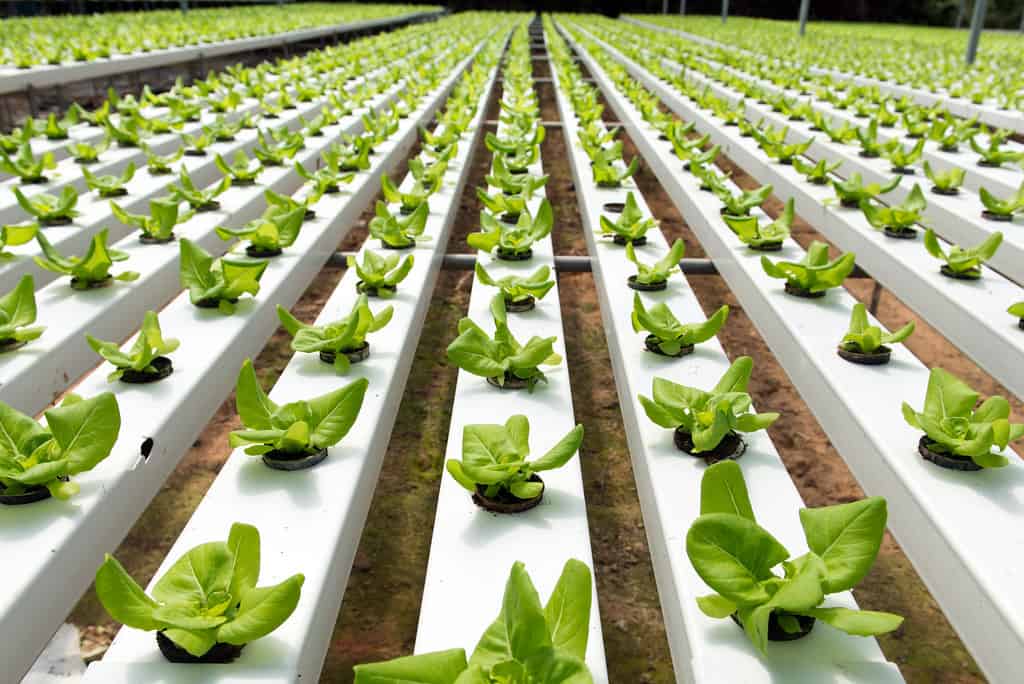
For thousands of years, humans have grown crops the same way: you plant the seeds in the soil, nurture them, and harvest when the time is right. But increasingly, the hydroponic approach is becoming more and more popular.
Hydroponic agriculture involves a method of growing plants without soil, typically using mineral nutrient solutions in a water solvent. In this system, plants can be grown with their roots in the nutrient solution alone. This technique allows for precise control over the plant’s environment, leading to faster growth, higher yields, and less water usage compared to traditional soil-based agriculture.
It is especially useful in areas with unsuitable soil conditions or limited space, like urban settings. This method reduces the need for pesticides and herbicides, minimizes the impact on the environment, and allows for year-round cultivation in controlled conditions.
But hydroponic agriculture also has its fair share of challenges.
For instance, the nutrient solution that is used to feed the plants can easily become contaminated with pathogens like E. coli. To prevent this from happening, growers can use chemicals or simply replace the contaminated solution — but this is wasteful and impractical. In the new study, researchers turned to a surprising ally to help disinfect the crops: plasma.
“Our results suggest a completely new way of disinfecting,” author Professor Masafumi Ito of Meijo University said. “Our technology can potentially reduce the production of pesticides that use fossil fuels, pollution of the environment, and residuals.”
Plasma vs pathogens
Plasma is essentially hot gas with ions and electrons that produce small electric charges. Contrary to the high heat we typically expect, plasma can actually vary greatly in temperature. For their research, the team created low-temperature plasma, using a conventional plasma generator.
The idea is to take advantage of the plants’ ability to use chemicals (which is different from the ability of pathogens). Essentially, the methods target an amino acid called tryptophan commonly used in fertilizers. Tryptophan is very useful in plant development and is regularly used in fertilizers to enhance plant growth and stress resistance. It’s also used as a precursor in the production of natural compounds with antimicrobial properties, offering a sustainable approach to managing plant health and yield.
When the amino acid is irradiated, the plasma electrons generate unstable oxygen particles. These go on to produce unstable tryptophan particles. The plants can still use these particles, but the pathogens can’t. Essentially, this starves E. coli while not affecting the plants.
“We developed a sterilization technology using oxygen radicals, which is promising as a hygiene control technology for nutrient solution in modern hydroponic cultivation,” said lead author, Professor Kenji Ishikawa of the Nagoya University Center for Low-temperature Plasma Sciences.
“As the use of chemical pesticides is restricted under the Sustainable Development Goals and the Green Strategy, our innovative technology can be used for sterilization simply by converting the atmosphere containing nitrogen, oxygen, and water vapor into low-temperature plasma based on electrical energy obtained from natural energy. This technology is expected to promote technological development toward the goal of eliminating fossil fuels and reducing greenhouse gases.”
A new way to grow vegetables
Innovations like this can go a long way towards making hydroponic agriculture more practical. Despite its immense potential, hydroponics has not yet established itself as a truly mainstream. Primarily, this is due to its higher initial setup and operational costs compared to traditional soil farming. The investment in equipment, technology, and expertise required for setting up hydroponic systems can be substantial. Beyond that, managing a hydroponic system can also be challenging.
The research on tryptophan’s bactericidal effects via oxygen radical irradiation can significantly enhance the reliability of hydroponic agriculture by providing a relatively cheap and environmentally friendly method to control bacterial contamination in nutrient solutions. By integrating this approach, hydroponic systems can maintain healthier plant growth environments, making hydroponics a more attractive and viable option for farmers looking for efficient and eco-friendly cultivation methods.


